When I was a kid I enjoyed going to orchestra concerts with my best friend and her family. While I enjoyed every bit of music I heard I always wondered what instruments were hiding in the back behind all the strings.
Well that my friend, was the orchestral percussion section. One of the most fascinating sections in the orchestra!
Orchestra percussion is the collection of percussion instruments most commonly used in an orchestral setting: the chimes, gongs, maracas, tambourines, concert bass drum, snare drum, triangle, cymbals, xylophone, timpani, and piano.
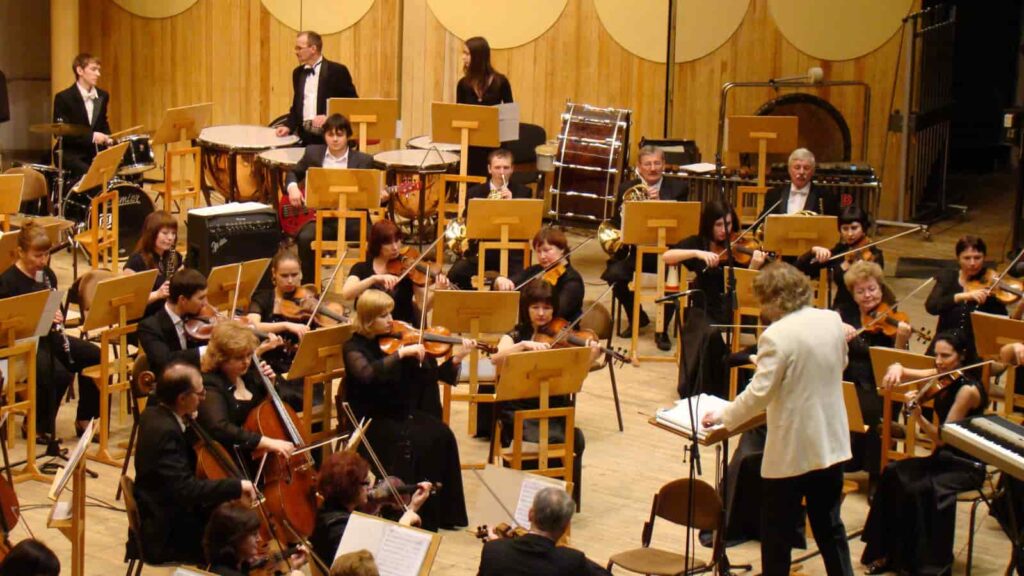
Orchestral percussion is one of the oldest instrumental sections you’ll hear in today’s orchestras!
The percussion section has hundreds of instruments with a variety of uses and sounds. Keep reading to discover some musical history and be introduced to the most commonly used percussion instruments in the orchestras since 1817 till today.
What percussion is used in an orchestra?
Every orchestra may have a slightly different variety of percussion instruments but generally, you will find the most popular ones to be the following.
- Glockenspiel / Bells
- Vibraphone
- Xylophone
- Marimba
- Piano
- Concert Bass Drum
- Snare Drum
- Concert Tom
- Timpani
- Cymbals
- Suspended Cymbal
- Crash Cymbals
- Gongs
- Triangle
- Tambourine
- Chimes
- Celesta
These instruments usually belong to one of three main groups. The Mallet instruments, the Drums (or membrane) instruments, and the Auxillary instruments.
There are many ways to group or classify percussion instruments in the orchestra section. For this article we will go with the first method.
Mallet instruments or Membranes or Auxillary
Idiophones or Membranes
Tuned or Untuned
Mallet Instruments (tuned):
Mallet instruments like the Glockenspiel, Vibraphone, Xylophone, and Marimba are tuned and have a “keyboard” that looks like a piano.
Mallet instruments are played with mallets made from a variety of plastics, rubber, or wood. Each of these instruments have tone bars that vibrate and make a sound when struck by a mallet. Some of these instruments employ resonator tubes under the tone bars to help amplify the sound.
Glockenspiel/Bells
The Glockenspiel (or Bells) is made of metal and produces a metallic, high-pitched sound that can cut through the loudness of a full orchestra or can be used as a quiet, yet distinct, sound to accent or create lightness in a piece of music.
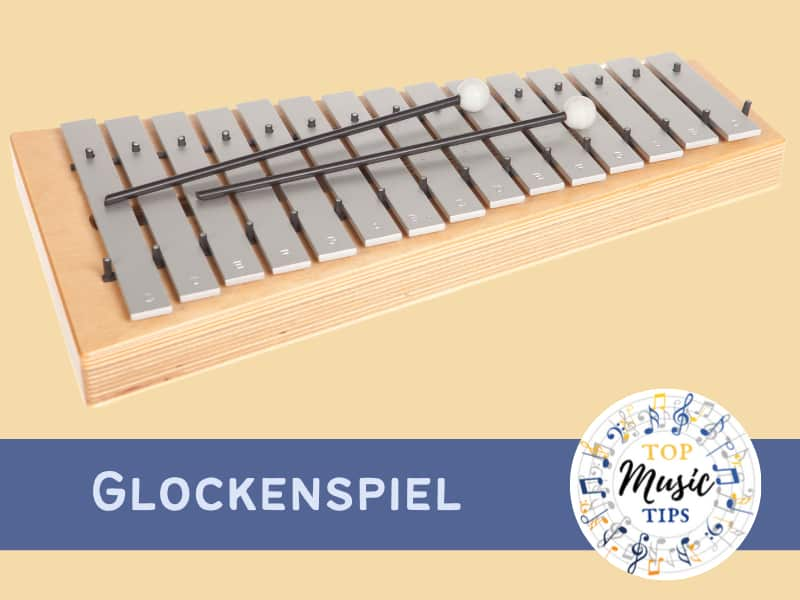
The name glockenspiel originates from Germany and is translated “to play the bells”, or “bell play.” The original glockenspiels were not tone bars but a group of actual bells which were struck by a group of musicians.
Vibraphone
The Vibraphone has metal tone bars like the Glockenspiel.
The Vibraphone has a larger and lower range of sounds and tones than the Glockenspiel and is able to sustain and vibrate its tone longer.
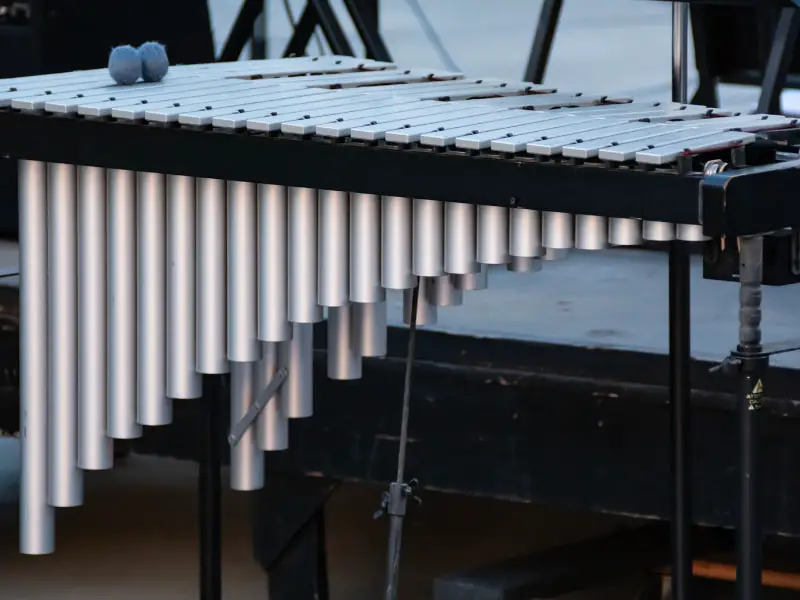
It sustains its tone through the use of resonator tubes and a damper pedal.
When the pedal is pressed down, the tone bars are free to ring and resonate. When the pedal is released, the tone bars are dampened and produce a short dampened sound.
🎵 Note: Vibraphones are great for making doorbell sounds! Here is an audio clip of a Vibraphone. Notice how is resonates.
The addition of a variable-speed motor also makes the vibraphone unique. The motor controls panels that are placed in each resonator tube.
If the motor is set to a fast speed, the tone will have a fast vibration because the panels are spinning quickly. If the motor is set to a slow speed, the tone will have a slow, “wha wha” like vibration sound because the panels are spinning slowly.
Vibraphones are also used as solo instruments and ensemble instruments in Jazz bands or combos.
Xylophone
A Xylophone is a historic instrument that comes from tribal cultures around the world. The earliest xylophones were logs laid across a player’s legs or laid across a hole in the ground to resonate and amplify the sound.
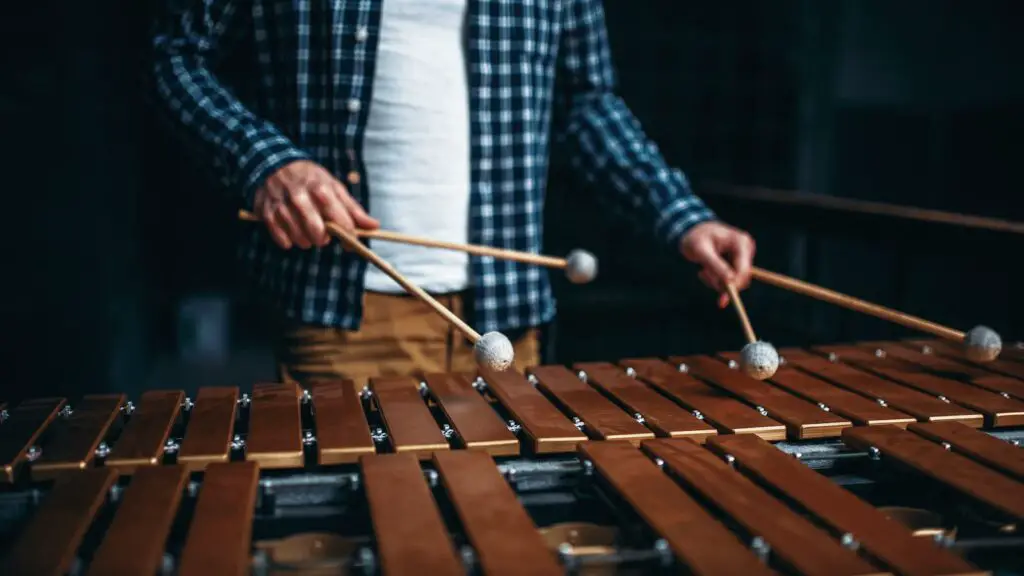
Xylophones were notably used in Europe beginning in the 1500s and the logs were transformed into bars and placed on straw. Current xylophones are constructed on stands and have wood tone bars that are cut to a certain shape and suspended so that they resonate once they are struck.
Marimba
The Marimba is similar to the xylophone but has a larger range of notes, a mellower sound, and more resonator pipes to amplify every tone bar.
The marimba, like the vibraphone, is often used as a solo instrument. Compared to the xylophone, the marimba has a much softer tone which blends in with woodwinds and strings in the orchestra.
The following video is an amazing solo performed on the Marimba and xylophone. It has over 9 million views!
Drums / Membrane Percussion Instruments
Drums are membrane percussion instruments that produce a sound when the membrane (drum head) is struck or stoked. Percussion instruments in the membrane family include the Snare Drum, Bass Drum, Bongos and Congas, the Headed Tambourine, Timpani, Tabla, and many others.
Concert Bass Drum
The Concert Bass Drum is one of the largest drums in the orchestra percussion section, ranging from 28 to 40 inches across.
It provides the booming downbeats and accents while being able to be quietly muffled or forcefully struck. The concert bass drum sounds hard or round depending on the size and structure of the mallet used to strike it.
Here is a fun Concerto (solo) for Bass drum with the orchestra. This video really show the versatillity of the instrument!
🎵 Note: The concert bass drum is one of the largest instruments in the orchestra.
Snare Drum
The Snare Drum has a unique and recognizable sound. The snare drum sounds like a snap or a crack when hit with a drumstick.
This classic sound is produced by a group of “strainers” placed tightly on the bottom drum head. The bottom drum head is thinner and more sensitive to vibration than the top (or batter) head. The strainers are stretched tightly against the bottom head and adjusted to the desired sound.
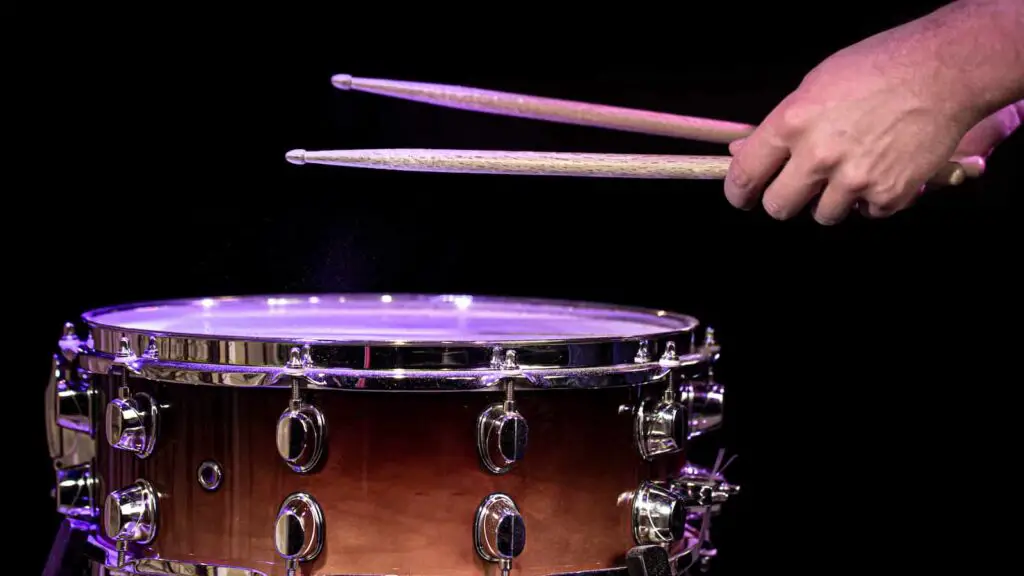
A snare drum can be adjusted to make a short, quick, snapping sound, or a longer, buzzing sound just by adjusting how tight the drum heads are and how tightly stretched the strainers are.
The strainers can be made of wire, string, or a combination of other materials and metals. Some strainers are made of plastic and produce a less metallic snap from the drum.
Concert Toms
Concert toms are tuned drums that can be played as a single or a set of different sizes. The toms come in two varieties: single-headed or double-headed (having a drum head on both the top and bottom of the drum).
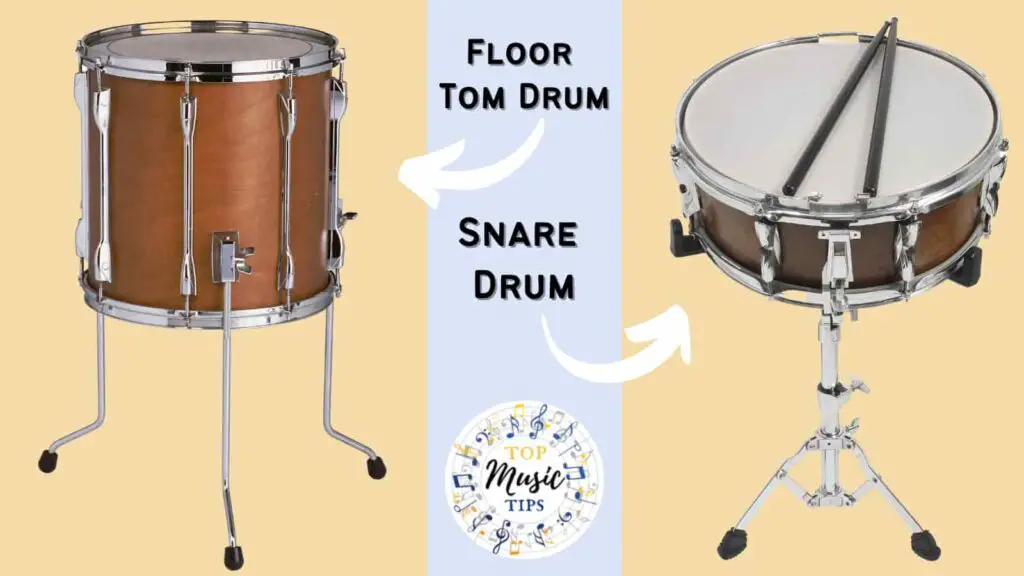
These drums are used to add a variety of tones to percussive moods and sound almost tribal. (If they look familiar, that is because concert toms are also a main component on a drumset.)
Timpani
Timpani have been used in music since Medieval times and have worked their way into Operas, orchestras, concert, and marching bands. Even some rock drummers have included timpani in their large drum sets.
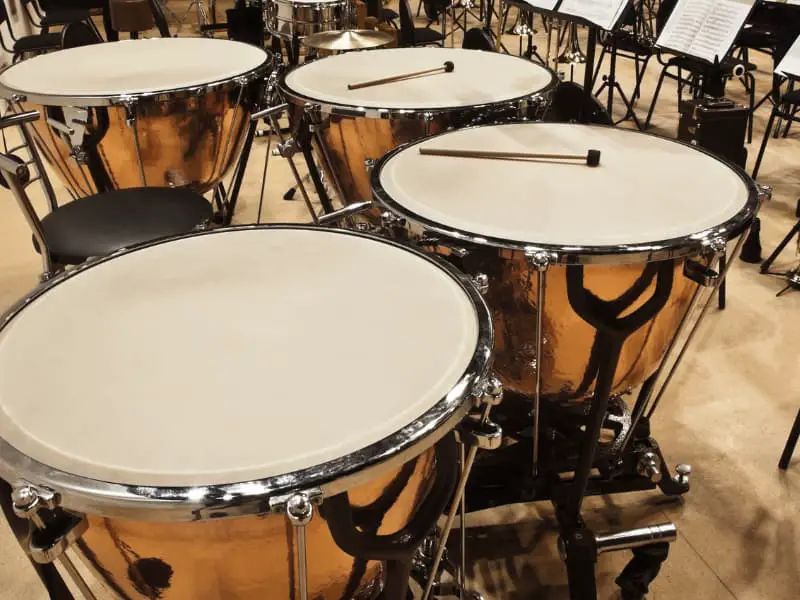
The typical four drum Timpani set has drum head sizes of 23”, 26”, 29”, and 32”. Some advanced orchestras may add a fifth drum (20”) for higher pitches.
Auxiliary Percussion
Auxiliary percussion includes instruments like Shakers, the Slap Stick, Jingle Bells, the Triangle, and Tambourines. Each auxiliary percussion instrument has a specific technique and correct way to play it in order to get the best sound from it.
The complete list of Auxiliary percussion is a curious combination of sticks, whistles, things that vibrate, and even an anvil.
🎵 Note: A typewriter was used as a percussion instrument by American composer Leroy Anderson in his composition entitled “The Typewriter” 1950. It was first performed and recorded by the Boston Pops Orchestra in 1953.
Cymbals and Gongs
Some of the loudest sounds in the orchestra’s percussion section come from the cymbals and gongs. Their purpose for using cymbals and gongs is to accent and grab the attention of the listener as well as build anticipation and suspense.
Crash Cymbals
Crash cymbals are played by holding the straps that suspend them and “crashing” them together with specific technique. The sound created is meant to accent, surprise, and articulate specific moods and events in orchestral music.
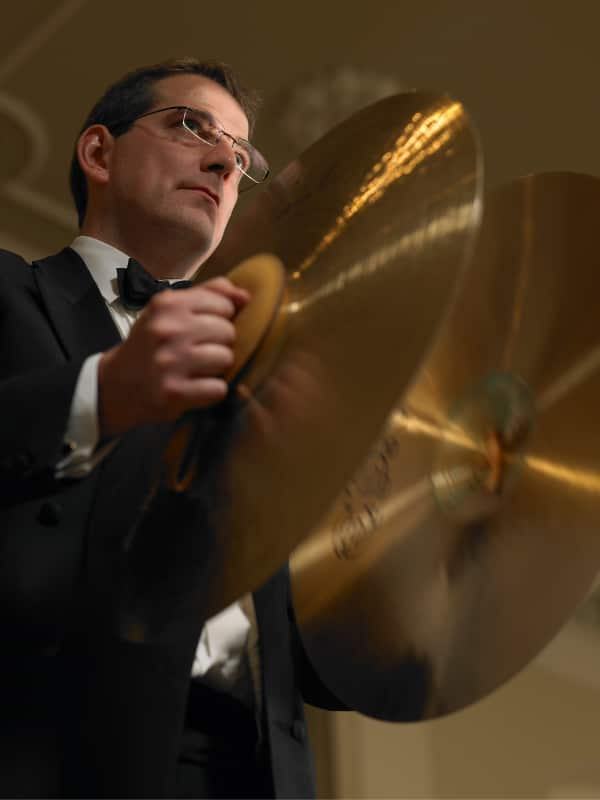
Suspended Cymbal
A suspended cymbal is similar to the crash cymbal but since it is put onto a stand (or suspended in air) there are a variety of other sounds that can be created other than just a “crash.”
The suspended cymbal has an encyclopedia of sounds that can be produced depending on where and how you strike it. The cymbal makes a different sound when stuck or tapped on the extreme edge, the outer edge, in the space between the edge and the bell, or on the bell.
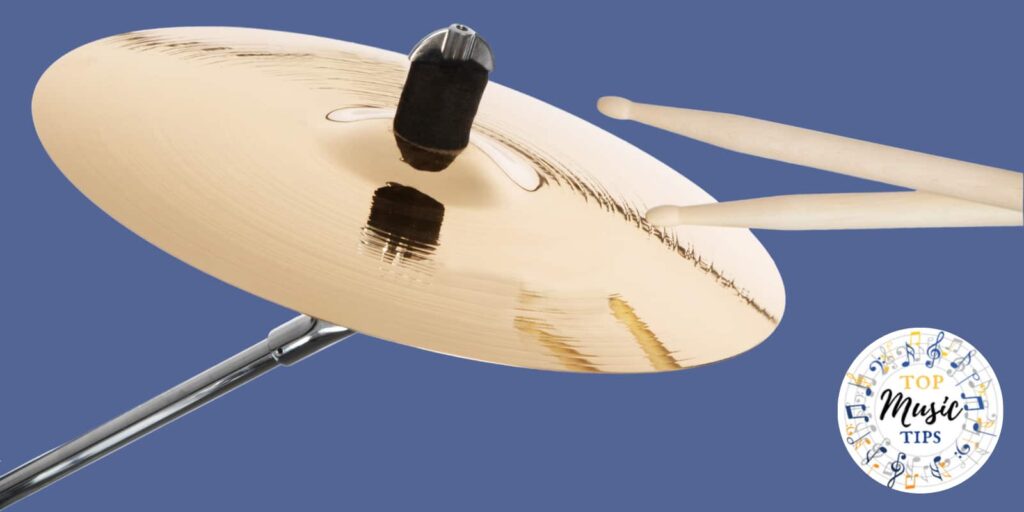
You can also produce a crescendo or loudly expanding sound by using soft mallets on the cymbal in a repetitive fashion.
🎵 Note: There are a lot of sound possibilities with just one cymbal. All of these sound possibilities can change with the diameter of the cymbal.
Gong & Tam Tam
The gong and tam tam are very similar in shape sound and size. In the orchestra they are very distinct and unmistakable in their oriental and booming sound. These percussion instruments are used to set a specific mood or to act as an accent which can be louder than the entire orchestra.
🎵 Note: The Tam Tam made its way into the orchestra thanks to Francois-Joseph Gossec. Gossec used the instrument as part of a funeral march in 1791.
Orchestra Percussion FAQ
There are a lot of questions when it comes to how orchestra percussion sections work. Here are some of the most popular ones below.
How many percussion instruments are in the orchestra?
There are over 500 unique instruments in percussion. The percussion family of instruments has a long history of existence and evolution. There are many ways to divide and classify percussion instruments including by tuned or untuned, melodic or non-melodic, headed (membrane) or non-headed.
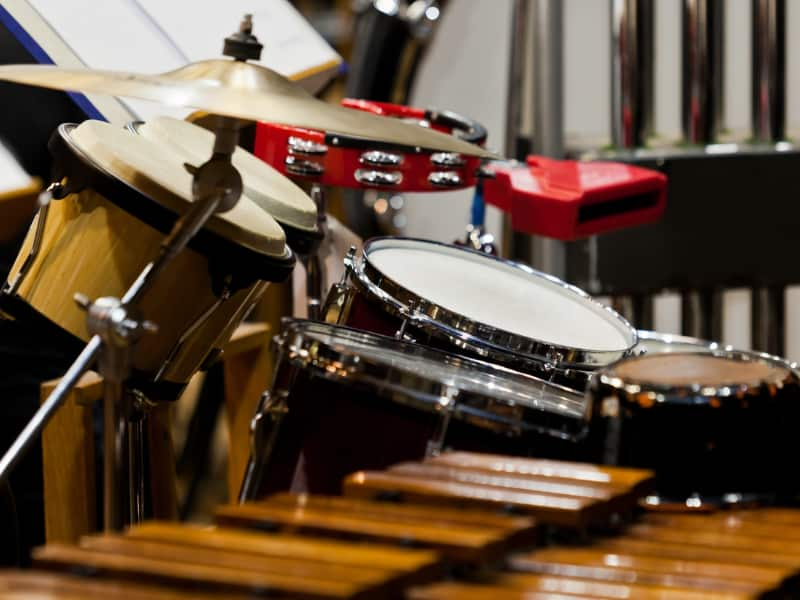
Do orchestras have drums? What are orchestral drums called?
Most if not all orchestras have many different types of drums. The orchestral drum section is called the percussion section and includes many other interesting percussive instruments as well.
The percussion family of instruments has hundreds of instruments that are very useful for creating rhythm, introducing a variety of dynamics, and providing sound effects.
The drums included in the orchestral percussion section are generally these types of drums:
- Snare Drum
- Timpani
- Concert Bass Drum
- Tom Tom
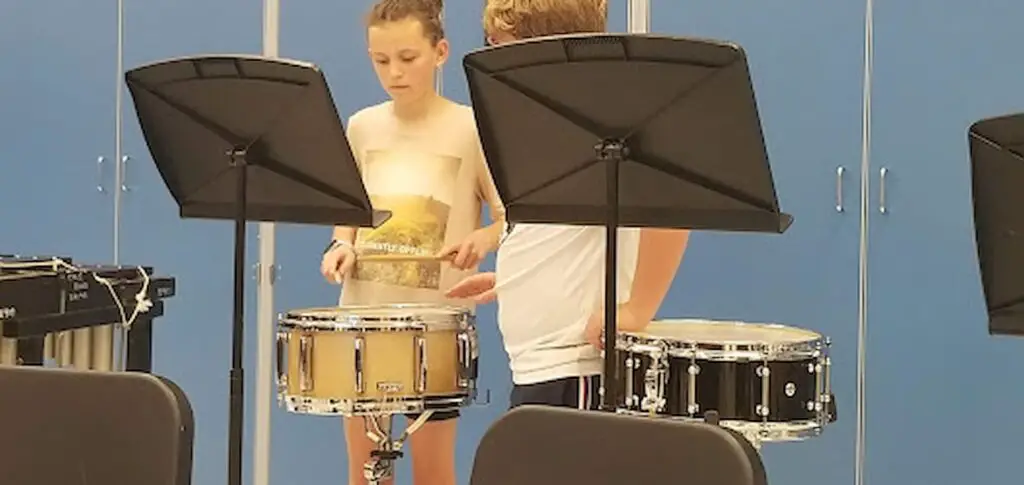
What is that bowl drum called?
The bowl-looking drum is called the timpani or Kettle Drums. Orchestral Timpani are normally played in a set of four or more drums.
The typical four drum Timpani set has drum head sizes of 23”, 26”, 29”, and 32”. Some advanced orchestras may add a fifth drum (20”) for higher pitches. The Timpani are different sizes to allow for more pitches or tones.
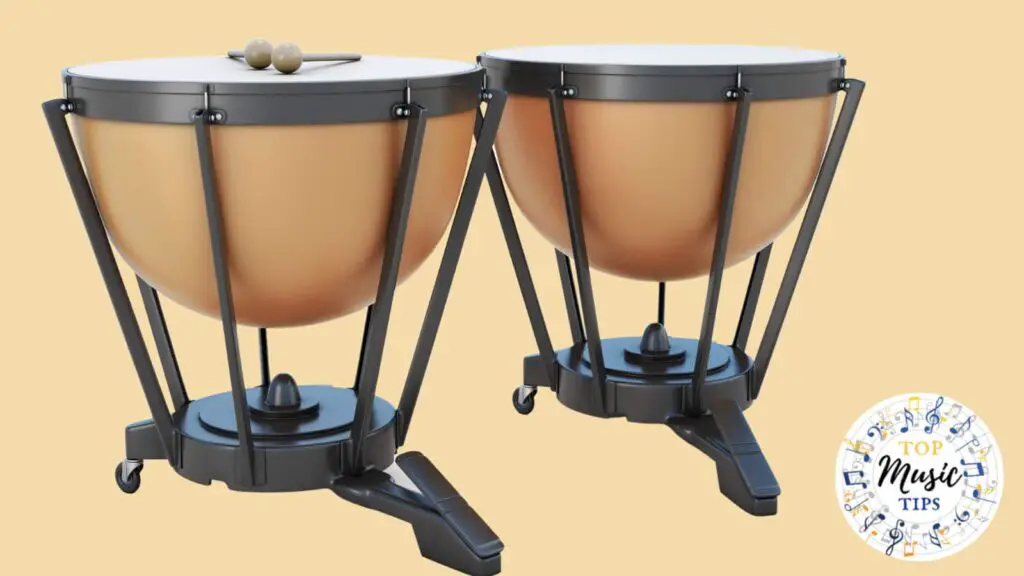
Did classical music have percussion?
Yes, classical music had percussion. The last half of what’s known as the Classical Music Era (18th century) is when percussion was added to the orchestra.
By the end of the Classical Era the orchestra instrumentalist included:
- Violins
- Violas
- Violas
- Violoncellos
- Double basses
- Flutes
- Oboes
- Clarinets
- Bassoons
- Horns
- Trumpets
- and Two Timpani
🎵 Note: Haydn used Percussion in Symphony No. 100. He used the triangle, bass drum, and hand crash cymbals.
When was percussion first used in orchestra?
Percussion was first used in orchestra in 1817 by Gioachino Antonio Rossini in his opera Armida. Rossini introduced the tam-tam (gong) during the finale in act three.
Percussion was used during Mozart’s time in the late 1700s, however it was specifically used for Turkish marching music during operas and was not adopted as a regular part of the standard orchestra.
Who introduced the percussion orchestra?
Edgar Varese introduced the percussion orchestra in 1930 with his piece titled Ionisation. This piece features 30 different percussion instruments played by 13 performers.
Alexander Tcherepnin had a movement for percussion alone in Symphony No. 1 in 1927, but it was an isolated movement contained within a symphony written for a full orchestra.
Which is the only percussion instrument used in the Baroque orchestra?
Timpani is the only percussion instrument used in the Baroque orchestra.
The pair of timpani used in the Baroque orchestra would be tuned to the tonic and dominant of the key of the orchestral piece. These drums evolved from ones used in the military processions for announcing the movement of troops.
How to organize a percussion section in an orchestra?
Each conductor will have their own unique take on how best to organize their orchestra percussion section.
The best way to organize the section will depend on the music being played and what percussive instruments it demands but here is the basic setup suggested by John R. Beck a very talented and experienced musician.
Organize a percussion section in the orchestra as follows: timpani, Bass drum, snare drum, cymbals, Auxiliary percussion, and keyboard instruments.
Diagram from: An Organized Percussion Section: The Key To Success by John R. Beck)
The percussion section is placed in the rear of the orchestra and in the center when possible or stretching across the back of the orchestra.
Up Next:
We hope were able to answer all your questions about percussion instruments in an orchestra setting. If we failed to answer all your questions please e-mail us ([email protected]) and we’ll add it to our list.
Here are some more articles we think you will enjoy.
A Beginners Guide to Band Percussion Instruments
6 of the Hardest Percussion Instruments to Learn
Disclaimer: This post may contain affiliate links. We only recommend high-quality products that are used and recommended by real musicians. If you use these links to buy something we earn a small commission.
